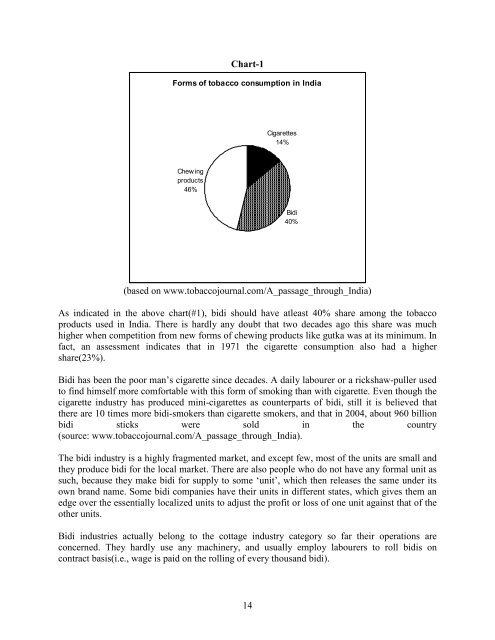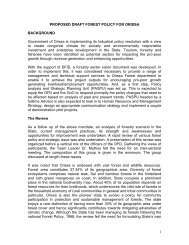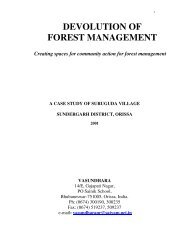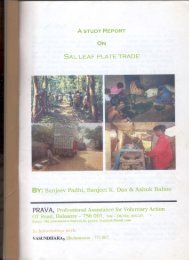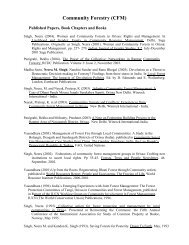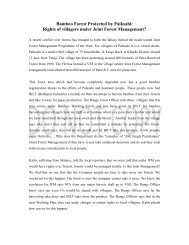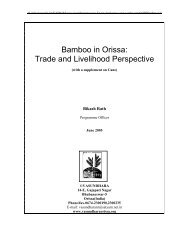The Kendu Leaf Trade: Problems & Prospects in Orissa - Vasundhara
The Kendu Leaf Trade: Problems & Prospects in Orissa - Vasundhara
The Kendu Leaf Trade: Problems & Prospects in Orissa - Vasundhara
You also want an ePaper? Increase the reach of your titles
YUMPU automatically turns print PDFs into web optimized ePapers that Google loves.
Chart-1<br />
Forms of tobacco consumption <strong>in</strong> India<br />
Cigarettes<br />
14%<br />
Chew <strong>in</strong>g<br />
products<br />
46%<br />
Bidi<br />
40%<br />
(based on www.tobaccojournal.com/A_passage_through_India)<br />
As <strong>in</strong>dicated <strong>in</strong> the above chart(#1), bidi should have atleast 40% share among the tobacco<br />
products used <strong>in</strong> India. <strong>The</strong>re is hardly any doubt that two decades ago this share was much<br />
higher when competition from new forms of chew<strong>in</strong>g products like gutka was at its m<strong>in</strong>imum. In<br />
fact, an assessment <strong>in</strong>dicates that <strong>in</strong> 1971 the cigarette consumption also had a higher<br />
share(23%).<br />
Bidi has been the poor man’s cigarette s<strong>in</strong>ce decades. A daily labourer or a rickshaw-puller used<br />
to f<strong>in</strong>d himself more comfortable with this form of smok<strong>in</strong>g than with cigarette. Even though the<br />
cigarette <strong>in</strong>dustry has produced m<strong>in</strong>i-cigarettes as counterparts of bidi, still it is believed that<br />
there are 10 times more bidi-smokers than cigarette smokers, and that <strong>in</strong> 2004, about 960 billion<br />
bidi sticks were sold <strong>in</strong> the country<br />
(source: www.tobaccojournal.com/A_passage_through_India).<br />
<strong>The</strong> bidi <strong>in</strong>dustry is a highly fragmented market, and except few, most of the units are small and<br />
they produce bidi for the local market. <strong>The</strong>re are also people who do not have any formal unit as<br />
such, because they make bidi for supply to some ‘unit’, which then releases the same under its<br />
own brand name. Some bidi companies have their units <strong>in</strong> different states, which gives them an<br />
edge over the essentially localized units to adjust the profit or loss of one unit aga<strong>in</strong>st that of the<br />
other units.<br />
Bidi <strong>in</strong>dustries actually belong to the cottage <strong>in</strong>dustry category so far their operations are<br />
concerned. <strong>The</strong>y hardly use any mach<strong>in</strong>ery, and usually employ labourers to roll bidis on<br />
contract basis(i.e., wage is paid on the roll<strong>in</strong>g of every thousand bidi).<br />
14


